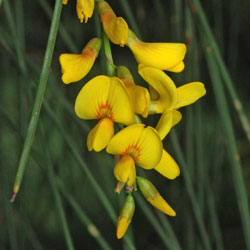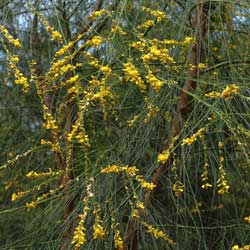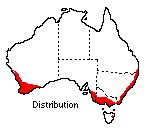Viminaria juncea
 |
 |
Native Broom
Viminaria juncea (Schrad. & J.C.Wendl.) Hoffmanns.
Native Broom is a unique species, being the only Viminaria known, and it grows wild only in Australia. It occurs in moist temperate parts of most States; not in Northern Territory nor in areas as dry as the Australian Capital Territory. In swamps it can be extensive, a tall loose shrub where crowded.
 It can be kept as a shrub amenable to trimming, but is most distinctive kept
to a single trunk when it reaches 6 m high. As a small tree it is upright and
the slender trunk has a dark fibrous bark. It contrasts with the crown of soft
green tints, a waving mass of slender branches which are bright grassy green
while young. They are long, in sprays, very smooth, extremely pliant and stands
up well to storms.
It can be kept as a shrub amenable to trimming, but is most distinctive kept
to a single trunk when it reaches 6 m high. As a small tree it is upright and
the slender trunk has a dark fibrous bark. It contrasts with the crown of soft
green tints, a waving mass of slender branches which are bright grassy green
while young. They are long, in sprays, very smooth, extremely pliant and stands
up well to storms.
As a shrub it resembles the introduced Broom (hence the common name), with smaller flowers, but is highly superior. It is brighter in appearance and unlike Broom will grow again after setbacks; thus it is long-lived.
Ordinary leaves are absent, except in seedlings and occasionally on young stems, and the tree is generally thought of as leafless. The leaves are in fact minute scales and the mass of growth consists of phyllodes, as in some Acacias.
In Viminaria juncea the phyllodes are 25 mm long, stringy, smooth and flexible, a fresh green and always appear healthy. Very rapid, clean growth in almost any soil is one great advantage of the species which can be put to any garden use in sun or shade. It is tough enough for planting in public gardens and quite hardy to frost in Canberra.
In November the branches become thickly lined with small, lemon-yellow* pea flowers 1 cm long, with a light clover-scent detectable from a large mass of plants. The season can last till mid December if cool and moist.
Seed sets in plenty, one small bean per pod, and this is an easy means of propagation. This species is usually obtainable from native plant nurseries. Autumn would be the best season to put out new plants in climates such as Canberra's.
*RHS Colour Chart, 1966, yellow
13A.
Text by ANBG staff (1974)
Photos by M.Fagg, APII collection.
Name meaning: Viminaria junceaViminaria - from the Latin, vimen, a pliant twig; juncea - rush-like |
![An Australian Government Initiative [logo]](/images/austgovt_brown_90px.gif)

